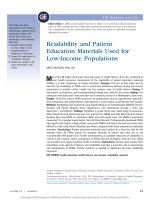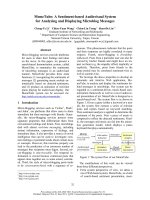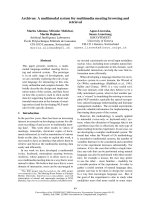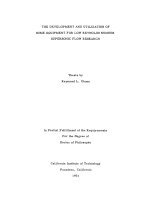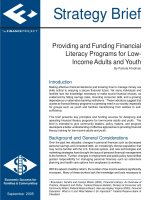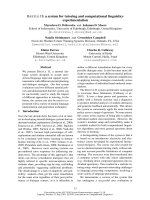Solar and thermal energy scavenging system for low power application
Bạn đang xem bản rút gọn của tài liệu. Xem và tải ngay bản đầy đủ của tài liệu tại đây (2.31 MB, 122 trang )
SOLAR AND THERMAL ENERGY SCAVENGING
SYSTEM FOR LOW POWER SENSOR
APPLICATION
KO KO WIN
(B. Eng.(Hons.), NUS, Singapore)
A THESIS SUBMITTED
FOR THE DEGREE OF MASTER OF ENGINEERING
DEPARTMANT OF ELECTRICAL AND COMPUTER
ENGINEERING
NATIONAL UNIVERSITY OF SINGAPORE
2011
ACKNOWLEDGEMENTS
First and foremost, I would like express my deepest gratitude to my
supervisor A/P Sanjib Kumar Panda for his persistent help, advice, encouragement
and providing me with this opportunity to pursue M.Eng. in the field of renewable
energy. In addition, I would like to also express my heartfelt thanks to Research
Scholar Mr Souvik Dasgupta for his support and concern for my research. I would
also like to express my appreciation to Mr Woo Ying Chee and Mr. M. Chandra from
the Electrical Machines and Drives Laboratory for assisting me with equipment and
essential logistical support.
Lastly, I would like to thank my fellow friends in the Electrical Machines and
Drives Laboratory and Power Electronic Laboratory for their support and
encouragement throughout the course of this project.
Page ii
Contents
ACKNOWLEDGEMENTS .......................................................................................... ii
Contents ....................................................................................................................... iii
List of Figures ............................................................................................................. vii
List of Tables................................................................................................................ xi
List of Acronyms ........................................................................................................ xii
List of Symbols .......................................................................................................... xiv
Chapter 1 : Introduction ................................................................................................ 1
1.1 Background ......................................................................................................... 1
1.2 Literature review ................................................................................................. 3
1.3 Motivation of the research work ......................................................................... 6
1.4 Organization of the thesis .................................................................................... 7
Chapter 2 : Solar Energy Harvesting System ................................................................ 9
2.1 Solar panel characteristics ................................................................................. 12
2.2 Classification of solar panel .............................................................................. 16
2.2.1 Commercially available solar panel technologies ...................................... 19
2.2.1.1 Monocrystalline solar panel ................................................................. 20
2.2.1.2 Polycrystalline solar panel ................................................................... 21
2.2.1.3 Thin Film/Amorphous solar panel ....................................................... 22
Page iii
2.3 Solar panel selection .......................................................................................... 23
2.3.1 Evaluation of different types of solar panel ................................................ 24
2.3.2 Selection of the solar panel ......................................................................... 29
2.4 Selection of energy storage devices .................................................................. 30
2.5 Maximum Power Point Tracking circuit design ................................................ 31
2.5.1 Existing MPPT control algorithms ............................................................. 32
2.5.1.1 Perturb and Observe (P&O) ................................................................. 33
2.5.1.2 Incremental Conductance (INC) .......................................................... 35
2.5.1.3 Constant Voltage (CV) ......................................................................... 37
2.5.2 Selection of MPPT control algorithm ......................................................... 39
2.5.3 Implementation of Constant Voltage MPPT method ................................. 42
2.6 Start-up circuit for solar energy harvesting system ........................................... 51
2.7 Battery Overcharge Protection circuit design.................................................... 53
2.8 Experimental Results ......................................................................................... 56
2.8.1 Experimental validation of the maximum power point operation and
efficiency of the solar energy harvesting circuit .................................................. 57
2.8.2 Field testing of the developed solar energy harvester with wireless sensor
node in outdoor environments ............................................................................. 63
2.8.3 Experimental validation of the Battery Overcharge Protection .................. 65
Page iv
2.9 Summary ........................................................................................................... 68
Chapter 3 : Thermal Energy Harvesting System......................................................... 69
3.1 TEG characteristics ........................................................................................... 72
3.2 Characterization of the selected TEGs .............................................................. 75
3.3 Selection of MPPT control algorithm ............................................................... 78
3.4 Controller design to implement Constant Impedance Matching MPPT method
................................................................................................................................. 81
3.4.1 Selection of DC/DC converter .................................................................... 82
3.4.2 Simulating TEG load impedance using buck-boost converter to ensure
MPPT ................................................................................................................... 84
3.4.3 Designing the circuit parameters to ensure MPP ........................................ 86
3.4.4 Design of square wave generator with adjustable duty ratio and frequency
(adjusting Ts and D in the analog circuit) ............................................................ 87
3.5 Experimental Results and Analysis ................................................................... 88
3.5.1 Experimental validation of the maximum power point operation of the
thermal energy harvesting circuit ........................................................................ 89
3.5.2 Efficiency of the thermal energy harvesting circuit.................................... 93
3.6 Summary ........................................................................................................... 95
Chapter 4 : Conclusions and Future Works ................................................................ 97
List of Publications ..................................................................................................... 99
Page v
Bibliography.............................................................................................................. 100
Page vi
List of Figures
Figure 1-1: Conventional two-stage DC/DC converter MPPT circuit [6]. ................... 3
Figure 2-1: Conventional two-stage DC/DC converter MPPT circuit [7]. ................. 10
Figure 2-2: Block diagram of the proposed solar energy harvesting system. ............ 12
Figure 2-3: Creation of Electron-hole pairs by incident electromagnetic irradiation
[21]. ............................................................................................................................. 13
Figure 2-4: Equivalent electric diagram of a solar panel ............................................ 13
Figure 2-5: Solar panel characteristics with solar intensity. ....................................... 15
Figure 2-6: Solar panel characteristics with solar panel temperature. ........................ 16
Figure 2-7: Examples of (a) Monocrystalline, (b) Polycrystalline and ....................... 20
Figure 2-8: Highly flexible thin-film amorphous silicon module [21]. ...................... 23
Figure 2-9: Solar panel characteristics and performance testing circuit. .................... 24
Figure 2-10: (a) AM-5605 (b) AM-8804 and (c) Custom made Polycrystalline solar
panel. ........................................................................................................................... 25
Figure 2-11: Power (W) vs. Voltage (V) plot of the AM-5605 Sanyo Amorphous
Solar Panel under varying solar insolation levels. ...................................................... 26
Figure 2-12: Power(W) vs. Voltage(V) plot of the AM-8804 Sanyo Amorphous Solar
Panel under varying solar insolation levels. ................................................................ 27
Figure 2-13: Power (W) vs. Voltage (V) plot of the Polycrystalline Solar Panel under
varying solar insolation levels. .................................................................................... 28
Figure 2-14: Showing MPP on solar panel characteristics plots: Power (W) vs.
Voltage (V) and Current (A) vs. Voltage (V). ............................................................ 32
Page vii
Figure 2-15: Perturb and observe (P&O) algorithm. .................................................. 34
Figure 2-16: Oscillations around PMPP when finding MPP using P&O algorithm. .... 35
Figure 2-17: Incremental conductance algorithm [43]............................................... 37
Figure 2-18: Constant voltage algorithm. .................................................................. 38
Figure 2-19: Solar panel output power curves under the different solar intensity
conditions with Vref = 1.79V (red line) and VMPP (black line)..................................... 41
Figure 2-20: DC/DC boost converter as an input voltage regulator. .......................... 43
Figure 2-21: Implementation block diagram of constant voltage MMPT. ................. 45
Figure 2-22: Constant Voltage MPPT control circuit schematic diagram. ................ 46
Figure 2-23: Control operation of op-amps 2 & 3. .................................................... 48
Figure 2-24: Boost Converter voltage and current waveforms. .................................. 50
Figure 2-25: S882Z and DC/DC boost converter connection diagram. ...................... 53
Figure 2-26: Commonly available methods of clamping the battery voltage: (a)
MOSFET needs low side driver; (b) MOSFET needs high side driver. ..................... 54
Figure 2-27: Battery overcharge protection circuit block diagram with the proposed
solar energy harvester. ................................................................................................ 55
Figure 2-28: Simple threshold detector for battery protection circuit........................ 56
Figure 2-29: Experimental waveform showing PV voltage (Vpv), PV current (Ipv),
Output voltage (VB) and Output current (Io) under solar insolation of 1000Wm-2. .... 59
Figure 2-30: Experimental waveform showing PV voltage (Vpv), PV current (Ipv),
Output voltage (VB) and Output current (Io) under solar insolation of 400Wm-2. ...... 61
Figure 2-31: Power Distribution of the developed solar energy harvesting system at
solar insolation of 1000Wm-2. ..................................................................................... 63
Page viii
Figure 2-32: Real Time battery voltage data during the field testing. ........................ 64
Figure 2-33: Photograph of the developed prototype. ................................................ 65
Figure 2-34: Battery Simulator Circuit Diagram. ....................................................... 66
Figure 2-35: Experimental waveform showing Gate voltage (G1), PV voltage (Vpv),
Output voltage (VB) and Output current (Io) under solar insolation of 1000Wm-2. .... 67
Figure 3-1: Schematic diagram of the proposed thermoelectric energy harvester for
low power application. ................................................................................................ 71
Figure 3-2: Schematic of a thermoelectric generator. ................................................. 72
Figure 3-3: Equivalent electric diagram of a TEG. ..................................................... 73
Figure 3-4: Schematic diagram of the series connected thermoelectric generators for
low power application. ................................................................................................ 76
Figure 3-5: TEGs characteristics and performance testing circuit. ............................. 77
Figure 3-6: Series connected 3 TEGs output power curves under the different ∆T
conditions. ................................................................................................................... 78
Figure 3-7: Schematic diagram of the buck-boost converter as load impedance
regulator in the proposed thermal energy harvester. ................................................... 81
Figure 3-8: Inductor current, iL, input current, ii, diode current, idiode, of buck-boost
converter at DCM. ....................................................................................................... 84
Figure 3-9: Tunable frequency square wave generator with adjustable duty ratio. .... 87
Figure 3-10: Photograph of the developed thermal energy harvesting system. .......... 89
Page ix
Figure 3-11: Experimental waveforms showing TEGs output voltage (vi), buck-boost
converter output voltage (vo), TEGs output current (ii) and Gating signal (vG) under
o
∆T = 24 C.................................................................................................................... 90
Figure 3-12: Experimental waveforms showing TEGs output voltage (vi), buck-boost
converter output voltage (vo), TEGs output current (ii) and Gating signal (vG) under
o
∆T = 28 C.................................................................................................................... 91
Figure 3-13: Experimental waveforms showing TEGs output voltage (vi), buck-boost
converter output voltage (vo), inductor current (iL) and Gating signal (vG) under ∆T =
o
24 C. ............................................................................................................................ 92
Figure 3-14: Experimental waveforms showing TEGs output voltage (vi), buck-boost
converter output voltage (vo), inductor current (iL) and Gating signal (vG) under ∆T =
o
28 C. ............................................................................................................................ 93
Figure 3-15: Power Distribution of the developed thermal energy harvester at ∆T =
24oC. ............................................................................................................................ 95
Page x
List of Tables
Table 1-1: Power Densities of Harvesting Technologies [2] ........................................ 2
Table 2-1: Comparison on efficiency for the different types of solar panel ............... 29
Table 2-2: Comparison between different MPPT techniques ..................................... 39
Table 2-3: Summary of power difference between at Vref and VMPP ........................... 40
Page xi
List of Acronyms
AC
Alternating Current
ADC
Analog to Digital Converter
BIPV
Building Integrated Photovoltaic
CCM
Continuous Conduction Mode
CIGS-CIS
Copper Indium Gallium Selenide - Copper Indium Selenium
CdTe
Cadmium Telluride
CV
Constant Voltage
CVD
Chemical Vapour Deposition
CZ
Czockralski
DC
Direct Current
DCM
Discontinuous Conduction Mode
DC/DC
DC to DC
DSC
Dye-sensitized Solar Cell
IC
Integrated Circuit
INC
Incremental Conductance
MPP
Maximum Power Point
MPPT
Maximum Power Point Tracking
MOSFET
Metal–Oxide–Semiconductor Field-Effect Transistor
NiCd
Nickel Cadmium (NiCd)
NiMH
Nickel Metal Hydride (NiMH)
Li+
Lithium based
SLA
Sealed Lead Acid
Page xii
NMOS
N-channel MOSFET
PMOS
P-channel MOSFET
PI
Proportional-Intergral
PMC
Power Management Circuit
P&O
Perturb and Observe
PV
Photovoltaic
PWM
Pulse Width Modulation
TEG
Thermoelectric Generator
Page xiii
List of Symbols
W
Watts
V
Volts
C
Coulomb
k
Boltzmann‘s Constant
q
electron charge
T
Temperature
ISC
Short Circuit Current
VOC
Open Circuit Voltage
Vpv
Photovoltaic/solar output voltage
Ipv
Photovoltaic/solar output current
Vo, Vout
Output voltage
VB ,VBAT
Battery voltage
Vin , Vi
Input voltage
Ii
Input current
Io
Reverse saturation current
Ip
Photocurrent
Ts
Sampling/switching Period
fs
Sampling/switching frequency
RL ,RLoad
Load resistance
Ri
Input resistance
Rs
Series resistance
ITEG
Current generated by a thermoelectric generator
Page xiv
RTEG
Internal resistance of a thermoelectric generator
Rp
Parallel resistance
∆T
Temperature difference between hot and cold sides
VTEG
Voltage generated by a thermoelectric generator
IMPP
Current at Maximum Power Point
VMPP
Voltage at Maximum Power Point
PMPP
Power at Maximum Power Point
Pin , Pi
Input Power
Pout , Po
Output Power
D
Duty Ratio
η
Efficiency
n
Nano
µ
Micro
m
Milli
k
Kilo
M
Mega
F
Farads
H
Henry
Ω
Ohms
Page xv
Chapter 1 : Introduction
In this Chapter, a brief evaluation of the different types of energy scavenging
system such as energy extraction from solar and thermal energy sources for wireless
sensor nodes used for condition monitoring applications are investigated. In this
chapter, a brief survey on the present state of art technology in energy scavenging
system for wireless sensor nodes is discussed and the motivation of the work is
presented. The structure of this thesis is also portrayed in this Chapter.
1.1 Background
Portable computing systems/devices are becoming increasingly popular and
range from laptops, personal digital assistants (PDAs), and cell phones to emerging
platforms such as wireless sensor networks. Recent advances in wireless
communication technologies, sensors and integrated microelectronics technologies
have shifted the onus on to the human imagination to find innovative applications to
employ wireless sensor networks. It is not hard to imagine the use of such sensors to
collect information from potentially hazardous environments, and remote locations.
These sensors have become an indispensible aspect of condition monitoring
applications such as smart homes/offices, buildings, automotive, etc. - to improve the
human life-style. These sensors rely on electric power sources such as
alkaline/rechargeable batteries to provide electrical energy on a sustained basis for
effective operation. Due to the finite amount of stored energy in batteries, it is
Page 1
necessary to replace/recharge the batteries in a periodic manner to ensure that the
sensor node-life is extended. The replacement of batteries becomes a burden due to
many sensor nodes being deployed in the field or difficulties to access the sensor
nodes in certain environmental conditions. Hence, the portability of these devices is
limited by the size of the energy storage elements rather than the computational
power of the digital signal processor. Hence, available battery energy has become a
critical resource for such systems. The real challenge for such low power portable
electronic devices is to reduce or even eliminate the dependency on batteries and to
be truly autonomous and self-sufficient with regards to energy generation and
utilization. Recently, energy harvesting/scavenging from the environment has become
one of the possible solutions to extend the life time of the wireless sensor nodes and
has attracted wide research interest [1]. A variety of energy harvesting technologies
is available and Table 1-1 shows some of the potential energy generating sources [2].
Table 1-1: Power Densities of Harvesting Technologies [2]
Methods
Power Density
Solar cells
15mW/cm2
Piezo-electric
330W/cm3
Electromagnetic
116W/cm3
Thermo-electric
40W/cm3
Acoustic noise
960nW/cm3
Page 2
In order to address this challenge, energy harvesting technology has become an
emerging research field that strives to reduce battery dependency for low power
sensor applications. Reducing battery dependency can be achieved through improved
energy conversion from previously untapped renewable energy as well as unwanted
available energy sources such as solar, thermal, vibration etc. in the environment and
also through improved and efficient storage facilities of the extracted electrical
energy.
1.2 Literature review
Various types of renewal energy sources such as solar, thermal, etc. can be
investigated for powering the portable systems [1-13]. The research work on the
energy harvesting of the portable system is drawn the prime importance among the
researchers in the recent past.
Figure 1-1: Conventional two-stage DC/DC converter MPPT circuit [6].
Page 3
The solar energy harvester reported in [3 - 7] describe the popular topologies
45
utilizing the power electronic converter for maximum power point tracking (MPPT)
in the field of low power application.
Brunelli et. al and Dondi et. al in [6] and [7] emphasize the usage of two-stage
power management circuits for harvesting solar energy for wireless sensor nodes as
shown in Figure 1-1. It consists of two stages namely buck converter and external
DC/DC converter. The buck converter is employed to perform the MPPT with the
highest possible efficiency, whereas external DC/DC converter is engaged to regulate
the output voltage to match the load (wireless sensor node). It can be seen from
Figure 1-1 that the MPPT control circuit has engaged one pilot cell to track the
maximum power point of the main solar panel which is connected at the input of the
buck converter. The MPPT in this arrangement may be erroneous due to the reason
that the pilot solar cell and the main solar panel are subjected to different
semiconductor characteristics. Nevertheless this arrangement also calls for extra foot
print and sizing. Besides these, the drawback of such a two-stage scheme is
comparatively lower overall power conversion efficiency due to power loss in each of
the two stages of DC/DC converters. Besides these, two-stage power conversion
circuits are also likely to have more circuit elements, resulting in larger circuit foot
print. Additionally, it can be remarked that such two stages of the DC/DC converters
may undergo mutual dynamic instability issues if not design properly.
Power control circuit described in [3-5] relies on digital microcontroller based
MPPT system. However, use of microcontroller for the control circuit calls for extra
Page 4
power loss in the controller, analog to digital converter (ADC) and voltage as well as
current sensors. Hence, the overall efficiency of the scavenging system for low power
application is comparatively lower due to digital control system in power conversion
unit. The proposition in [6- 9] shows an analog circuit based power management
8
circuit for solar energy harvesting. The cited papers present the solar energy harvester
with very attractive power management features but the power consumed in the
power management control circuitry is neglected.
The thermoelectric energy harvesters are also playing a role in portable devices
such as wireless sensors nodes and laptop power supply application [10]11-12[13].
The thermoelectric energy harvesters are relatively easier to implement to harvest any
wasted heat in any plants or residential buildings to activate the smart sensor
networks for smart environment monitoring. There are different energy harvesting
techniques which are reported so far, can be seen in the cited papers, [14-20]. The
most attractive way of harvesting maximum thermal energy is using the MPPT
algorithms such as perturb and observe (P&O) algorithm [14 -16], constant
15
impedance algorithm [17] and [18] tracking method using a high performance low
power consumption microcontroller. Nevertheless the usage of any kind of
microcontroller results in significant energy loss in the energy harvesting system.
Moreover the MPPT searching methods are quite computational intensive, need
feedback sensors for voltage as well as current and use of ADCs. In [19] and [20], the
authors have exercised analog practice to replace the microcontroller at the expense
of Maximum Power Point (MPP) operation. It can also be noted from the cited papers
Page 5
that the overall operation of the energy harvester is subjected to varying efficiency
with the change of effective load of the system. Besides these, the loss of energy in
computing devices as well as circuit elements leads to poor overall efficiency of the
energy harvester and large circuit elements which leads to larger foot prints.
1.3 Motivation of the research work
If the architectures of the cited energy harvesters are concerned, the circuits use
two-stage power conversion, the first stage is dedicated for the MPPT tracking
followed by the second stage to ensure voltage control. Since most of the control
circuits of the harvesters are implemented with digital microcontrollers along with
peripherals and sensors, the power consumption inside the harvester unit itself is
increased. The microcontrollers are utilized to track the maximum power point using
either P&O, incremental conductance (INC), or constant voltage (CV) or constant
impedance method.
In the present report, the extensive study has been carried out on different types
of solar and thermal energy harvesting systems. The main focus of this report is to
develop energy efficient solar and thermal energy harvesters for low power wireless
sensor applications.
In case of solar energy harvester, a one stage constant MPPT voltage method
based energy harvester is proposed. The whole circuit is implemented with low cost
and low power consumption analog integrated circuit (IC) to minimize the power loss
Page 6
of the overall energy harvesting system. The proposed method also ensures high
performance control of the power converter circuit with adequate band of accuracy.
An efficient thermal energy harvester is also proposed in this report to track the
maximum power point (MPP) of the thermoelectric generator (TEG). The energy
harvesting circuit is also implemented using the analog integrated circuit. The main
beauty of the proposed circuit lies in the open loop operation (without any sensors
and ADCs) of the energy harvester. The proposed circuit can be tuned to different
TEG samples based on their internal impedance, by characterizing the specific TEG
sample.
The proposed solar and thermal energy harvesting circuits are extensively
verified with rigorous experiments under different operating conditions to show the
efficacy of the overall system.
1.4 Organization of the thesis
The thesis is organized as follow:
Chapter 2 involves classification of different solar energy harvesting components
based on the solar panel characteristics, DC/DC converter properties as well as
different energy storage elements for the low power application such as wireless
sensor nodes. The chapter deals with selection of solar panel, energy storage devices,
power converters as well as control algorithms. A detailed analysis and experimental
Page 7
validation of a novel analog implementation of the non-linear control system is
provided. At the end of this chapter, a prototype test results are provided to test the
feasibility of the field implementation of the overall solar energy harvesting system.
Chapter 3 describes thermoelectric generator (TEG) application to harvest the
electrical energy for the power supply of the wireless sensor nodes. The details of the
chapter include TEG characterization, MPPT control algorithms and implementation
details of the thermal energy harvesting system. A novel method of using low cost
analog integrated circuit to implement accurate MPPT energy harvesting circuit is
proposed. A detailed analysis and experimental validation of the proposed system is
provided to support the efficacy of the proposed method.
Chapter 4 concludes the thesis and discovers the scope of some future works that
can be executed as an extension of this thesis.
Page 8
Chapter 2 : Solar Energy Harvesting System
Wireless sensor nodes are becoming more and more popular due to the
technological advancements in the field of microelectronics technology and the
development of ultra-low power microcontrollers that can be used in the embedded
system. Wireless sensor network (WSN) consisting of several sensor nodes are used
to monitor various parameters. The wireless sensor networks are commonly deployed
in civilian and military applications such as natural disaster detection, healthcare
system, traffic control system, building security system etc. [2]
Batteries are commonly used to power wireless sensor nodes. Due to the finite
amount of stored energy in batteries, it is necessary to replace/recharge the batteries
in a periodic manner to ensure that the sensor node-life is extended. The replacement
of batteries becomes a burden due to many sensor nodes being deployed in the field
or difficulties to access the sensor nodes in certain environmental conditions.
Recently, energy harvesting/ scavenging from the environment has become one of the
possible solutions to extend the life time of the wireless sensor nodes and has
attracted wide research interest [1].
From literature review, it can be seen that the research on solar energy
harvesting using solar panel, also known as photovoltaic (PV) cells, for low power
applications such as wireless sensor nodes has been carried out extensively.
Page 9
Figure 2-1: Conventional two-stage DC/DC converter MPPT circuit [7].
However, as shown in Figure 2-1, most existing applications implement the
solar energy harvesting using two stage DC/DC converters. The first DC/DC
converter is used for MPPT implementation and the other one is used for the output
voltage regulation [6 - 7]. Besides the need of two-stage converter, they also require
the sensors to extract the PV panel‘s instantaneous voltage and current readings from
a pilot PV cell (solar panel) to enable maximum power point tracking [6 - 7]. This
Chapter presents a simplified solar energy harvester design which employs single
stage DC/DC converter to perform both MPPT and the output voltage regulation.
Furthermore, no additional sensors will be used to realize the selected MPPT method.
A detailed study has been conducted to validate the proposed method. A prototype of
the solar energy harvester has been built and tested. Figure 2-2 shows the block
Page 10
